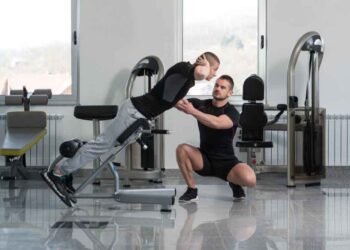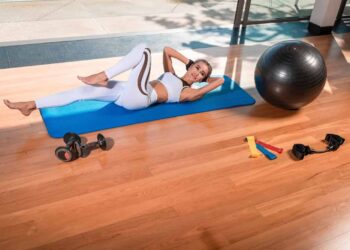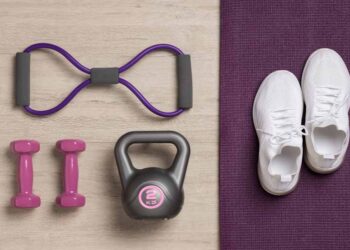Are you making these common treadmill mistakes that could be hindering your progress and putting you at risk for injuries? Treadmills are a popular choice for cardio and muscle-toning workouts, but it’s important to use them correctly to avoid common errors and stay injury-free.
In this article, we will explore some surprising treadmill mistakes that you might be making right now. From warming up properly to maintaining the correct running position and avoiding reliance on handrails, we’ll uncover the key aspects of a safe and effective treadmill workout. Plus, we’ll share some innovative treadmill workouts to revamp your fitness routine and keep you motivated.
So, before you step on that treadmill again, ask yourself: Are you unknowingly sabotaging your workout? Let’s find out.
Key Takeaways:
- Avoid common treadmill mistakes to prevent injuries and maximize your workout.
- Warm up properly before using the treadmill to reduce the risk of injury.
- Maintain the correct running position and wear appropriate shoes for a safe and effective workout.
- Avoid relying on handrails and focus on good running technique to maximize the benefits.
- Incorporate innovative treadmill workouts into your fitness routine to stay motivated and challenge your body.
Not Warming Up Properly
One of the most common mistakes people make when using a treadmill is not properly warming up before their workout. While you may be eager to start running and get your heart rate up, it’s important to take the time to warm up your muscles and prepare your body for the intensity of the exercise.
Warm up exercises, such as dynamic stretches, can help increase blood flow to your muscles and improve your flexibility. These stretches involve moving your body through a range of motion, helping to loosen up tight muscles and joints. Some examples of dynamic stretches include leg swings, arm circles, and walking lunges.
Another way to warm up before using the treadmill is to start with a brisk walk. This helps gradually increase your heart rate and body temperature, preparing your cardiovascular system for the more intense exercise that follows.
By warming up properly, you can reduce the risk of injury during your treadmill workout. When you warm up, your muscles are more pliable and responsive, making them less prone to strains or tears. Additionally, warming up increases your joint mobility and lubrication, allowing for smoother and safer movements.
So next time you hop on the treadmill, take a few minutes to warm up your body. Incorporate dynamic stretches and start with a leisurely walk to get your muscles and joints ready for the workout ahead. By taking this simple step, you can significantly reduce the risk of injury and optimize your treadmill experience.
Running Position and Footwear
When using a treadmill, it’s important to pay attention to your running position and the shoes you wear. Many people make the mistake of running too close to the front of the machine, which can lead to discomfort and even injury.
Running in the middle of the treadmill belt allows for proper arm swing and posture, reducing the risk of lower back pain and shoulder strain. By maintaining a centered running position, you can ensure that your body is aligned and balanced throughout your workout.
Another factor to consider is the type of shoes you wear while running on a treadmill. Wearing the wrong shoes can increase the risk of injuries to your hips and knees. Investing in a good pair of running shoes with proper support is essential for a safe and effective treadmill workout.
Proper footwear helps to cushion your feet and absorb impact, reducing strain on your joints. Look for running shoes that provide adequate arch support, cushioning, and stability. Taking the time to find the right pair of shoes for your feet and running form can make a significant difference in your overall comfort and performance.
Benefits of Optimal Running Position and Footwear
Maintaining the correct running position and wearing the right shoes offer several benefits:
- Reduces the risk of lower back pain and shoulder strain
- Improves overall posture and body alignment
- Minimizes the impact on joints, preventing injuries to the hips and knees
- Enhances comfort and reduces discomfort during your treadmill workouts
- Optimizes your running form, leading to improved running efficiency and performance
By focusing on your running position and footwear, you can ensure a safer and more enjoyable treadmill workout. Remember to always run in the middle of the treadmill belt and wear proper running shoes that provide adequate support. These small adjustments can have a significant impact on your overall treadmill experience.
| Running Position and Footwear Tips |
|---|
| 1. Run in the middle of the treadmill belt to maintain proper arm swing and posture. |
| 2. Invest in a good pair of running shoes with proper support, cushioning, and stability. |
| 3. Choose shoes based on your foot type and running form to minimize the risk of injuries. |
| 4. Replace worn-out shoes to maintain optimal support and cushioning. |
| 5. Consult with a professional at a specialized running store for expert advice on selecting the right shoes. |
Support on Handrails and Running Technique
When it comes to running on a treadmill, it’s easy to fall into the habit of relying too much on the handrails for support. However, this can have a negative impact on your workout and potentially lead to injuries.
First and foremost, leaning on the handrails while running disrupts your running technique and form. This can result in bad form, which not only hampers your performance but also puts unnecessary stress on your body. When you rely on the handrails, you may inadvertently adopt a more upright posture, leading to tension in your neck, shoulders, and back.
Instead of relying on handrail support, focus on running with proper form. This involves maintaining an upright posture, engaging your core muscles, and avoiding running on your heels. Running on the balls of your feet or midfoot strike is recommended, as it helps to absorb the impact and reduce the risk of injury.
Additionally, don’t forget to engage your arms while running. Proper arm swing is essential for maintaining balance and stability during your treadmill workout. Your arms should move naturally in synchronization with your legs, creating momentum and propelling you forward.
By avoiding excessive reliance on handrails and focusing on maintaining good running technique, you can prevent injuries and maximize the benefits of your treadmill workout. Remember, it’s all about finding the right balance between support and independence to ensure a safe and effective exercise routine.
Conclusion
By being mindful of these common treadmill mistakes and making the necessary adjustments, you can revamp your fitness routine and prevent injuries. Incorporating innovative treadmill workouts into your exercise regimen can keep you motivated and challenge your body in new ways. Remember to warm up properly, maintain the correct running position, wear appropriate shoes, avoid relying on handrails, and focus on good running technique. Stay injury-free and enjoy the many benefits of treadmill workouts.
Proper warm-up before a treadmill session is crucial in reducing the risk of injury. Starting with dynamic stretches or a brisk walk helps prepare your muscles for the workout ahead. By taking the time to warm up, you can enhance your performance and prevent muscle strains or pulls.
In addition to warm-up, paying attention to your running position is key. Avoid running too close to the front of the treadmill as it can lead to lower back pain and shoulder strain. Instead, aim to run in the middle of the treadmill belt to maintain proper arm swing and posture.
Wearing appropriate shoes is another essential aspect of a safe and effective treadmill workout. Invest in a good pair of running shoes that provide proper support to your feet, hips, and knees. This will help prevent injuries and allow you to perform at your best on the treadmill.
Lastly, avoid relying on handrails for support while running on a treadmill. Depending too much on handrails reduces the benefits of your workout and can create tension in your upper body. Focus on maintaining good running technique, avoid running on your heels, and engage your arms for a well-rounded and injury-free treadmill experience.












